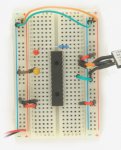The latest (May 2014) Australian "Silicon Chip" introduces Geoff "Back Shed" Graham's Micromite - a 28 pin skinny DIP Microchip PIC32MX150/250 32 bit micro that's pre-programmed with the free MMBasic firmware. A 44 pin SMD version with 33 I/Os is also available,as are diverse accessories - all at reasonable prices.
Fear not Rev.Ed - I for one consider the Micromite more of a PICAXE extension rather than competitor, especially since the BASICs are very akin. It may particularly appeal for fire breathing projects that demand greater memory,faster execution speeds and floating point maths than PICAXEs. Such needs otherwise may require tedious lower level coding, or bulky & costly hardware. Stan.
Fear not Rev.Ed - I for one consider the Micromite more of a PICAXE extension rather than competitor, especially since the BASICs are very akin. It may particularly appeal for fire breathing projects that demand greater memory,faster execution speeds and floating point maths than PICAXEs. Such needs otherwise may require tedious lower level coding, or bulky & costly hardware. Stan.


